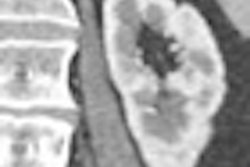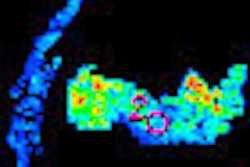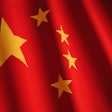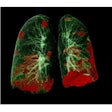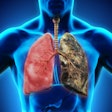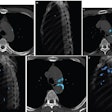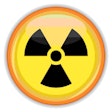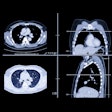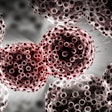For clinicians hoping to prevent contrast-induced nephropathy (CIN) in patients with impaired kidney function, sodium bicarbonate is starting to lose its fizz, according to research published this week in the Journal of the American Medical Association.
In the JAMA paper, as well as in a related study published last month in the Journal of the American College of Cardiology, sodium bicarbonate administration in the hours before iodinated contrast injection failed to significantly cut the postprocedural incidence of CIN compared to sodium chloride injection, although both research groups noted a statistically insignificant trend toward better outcomes with the use of sodium bicarbonate versus saline.
Following the publication of successful animal studies using sodium bicarbonate earlier in the decade, and a single randomized trial in human patients demonstrating superior results with the agent, some researchers have been hopeful that sodium bicarbonate might be more effective than other agents that have been tried (and have mostly failed) in efforts to prevent CIN, a cause of significant morbidity in patients with impaired renal function.
Ironically, patients at risk for CIN are more likely to need contrast injections for CT angiography and other contrast-enhanced imaging studies compared to the general population.
The pathophysiology of CIN remains complex and poorly understood. Some hypothesize that alkalinizing the urinary tract with sodium bicarbonate might sidetrack a principal mechanism of free-radical renal injury leading to CIN, while others propose to mitigate the effects of renal vasoconstriction resulting in medullary ischemia with protective agents.
Whatever the causes of CIN, the study in the September 3 JAMA found that the use of sodium bicarbonate for hydration during coronary angiography for patients with kidney disease did not cut the risk of developing serious kidney problems related to the use of contrast agents, compared to administration of a standard sodium chloride solution.
Contrast-induced nephropathy is "a common cause of renal failure associated with prolonged hospitalization, increased healthcare costs, and substantial morbidity and mortality," noted Dr. Somjot Brar from Columbia University Medical Center in New York City, along with colleagues from Kaiser Permanente and the University of California, Los Angeles (UCLA) School of Medicine, both in Los Angeles (JAMA, September 3, 2008, Vol. 300:9, pp. 1,038-1,046).
Occurring in as many as half of patients in high-risk populations, the risk factors for CIN include chronic kidney disease, diabetes, congestive heart failure, advanced age, anemia, and cardiac insufficiency, as well as the type and volume of contrast media used in the patient.
"The mechanism of contrast medium-induced nephropathy remains unknown, but may be related to renal vasoconstriction resulting in medullary ischemia or direct nephrotoxicity," they wrote. "In recent years, studies have investigated preventive therapies such as various plasma-expanding fluids, antioxidants (e.g., N-acetylcysteine [NAC] and ascorbic acid), diuretics, dopamine, fenoldopan, and hemofiltration, with mixed results."
In a 2004 study from the Carolinas Medical Center in Charlotte, SC, Merten and colleagues found that CIN occurred in eight patients (13.6%) who received sodium chloride prior to contrast administration, but in only one (1.7%) of those receiving sodium bicarbonate (mean difference, 11.9%; 95% confidence interval [CI], 2.6%-21.2%; p = 0.02) (JAMA, May 19, 2004, Vol. 291:19, pp. 2,328-2,334).
In this week's JAMA report, 353 patients with stable renal disease received iodinated contrast prior to contrast-enhanced coronary angiography. The median patient age was 71 years (interquartile range, 65-76, 65% men). All had impaired but stable renal function, with an estimated glomerular filtration rate (GFR) of 60 mL/min or less, and one additional risk factor including diabetes mellitus, hypertension, or history of congestive heart failure. Forty-five percent of patients had diabetes mellitus, Brar and colleagues reported.
The patients were randomly assigned to receive an infusion of either sodium chloride or sodium bicarbonate, stratified by diabetes status and N-acetylcysteine use at the discretion of the referring physician.
The patients received sodium chloride (n = 178) or sodium bicarbonate (n = 175) administered at the same rate of 3 mL/kg for an hour before coronary angiography. Serum creatinine levels were obtained at baseline, prior to contrast administration, and postprocedurally on days 1, 2, or 3 after angiography. The primary end points were a 25% or greater decrease in the estimated GFR on days 1-4 following exposure to the contrast agent, Brar and colleagues wrote.
The two treatment groups were well matched for demographic, clinical, hemodynamic, and angiographic characteristics. The percentage of diabetes patients and degree of control (as measured by hemoglobin) were also very similar.
Overall, contrast-induced nephropathy assessed by estimated GFR occurred in 13.9% (45/323) of the patients. "The group receiving sodium chloride hydration had a 14.6% (24/165) incidence versus 13.3% (21/158) in the sodium bicarbonate group, for a relative risk of 0.94 (95% CI, 0.55-1.60; p = 0.82)," they wrote. Moreover, there was no significant difference in serum creatinine levels between the treatment groups, and the amount of contrast media the groups were exposed to was also similar.
Other measures that were similar between the groups receiving sodium bicarbonate versus sodium chloride during the first 30 days included the rates of death (1.7% versus 1.7%), dialysis (0.6% versus 1.1%), myocardial infarction (0.6% versus 0%), and cerebrovascular events (0% versus 2.2%, respectively), according to the authors. At 30 days to six months, the same events occurred in 0.6% versus 2.3%, 0.6% versus 1.1%, 0.6% versus 2.3%, and 0.6% versus 1.7%, for sodium bicarbonate and sodium chloride patients, respectively.
"The results of this study do not suggest that hydration with sodium bicarbonate is superior to hydration with sodium chloride for the presentation of contrast medium-induced nephropathy in patients with moderate to severe chronic kidney disease who are undergoing coronary angiography," Brar and colleagues concluded. "Any true difference between the hydration strategies is likely to be small and not clinically significant."
The conclusions differ from two earlier reports on the topic, both of which suffered from low sample sizes, they added. In the 2004 study by Merten and colleagues, CIN occurred in 1.7% of 60 patients randomized to receive sodium bicarbonate and in 13.6% of 59 patients who received sodium chloride. The study was halted after enrollment of 119 patients, and patients received both intra-arterial and intravenous contrast, which increases the risk of CIN.
In the Renal Insufficiency Following Contrast Media Administration (REMEDIAL) trial by Briguori and colleagues, the sample size was again small, and a reduction in CIN was found with the use of both sodium bicarbonate and double-dose NAC, Brar and colleagues wrote.
Similar results in Italy
In the JACC study, by Dr. Mauro Maioli and colleagues from Misericordia e Dolce Hospital in Prato, Italy, the authors sought to compare the efficacy of sodium bicarbonate versus isotonic saline in addition to NAC (in all patients) for the prevention of CIN in patients with renal dysfunction undergoing angiography or other coronary intervention.
The prospective study included 502 patients with renal impairment (creatinine clearance < 60 mL/min) who were randomized to receive infusions of either saline or sodium bicarbonate before and after the administration of iso-osmolar contrast medium. Contrast-induced nephropathy was defined as an absolute increase in serum creatinine ≥ 5 mg/dL within five days of the intervention (JACC, August 19, 2008, Vol. 52:8, pp. 599-604).
The results showed that CIN occurred in 54 patients (10.8%), including 25 (10%) treated with sodium bicarbonate and 29 (11.5%) treated with saline (p = 0.60). The increase in serum creatinine in CIN patients did not differ significantly between the bicarbonate group (0.9 ± 0.6 mg/dL) and the saline group (0.7 ± 0.2 mg/dL, p = 0.015).
"Hydration with sodium bicarbonate plus NAC before contrast medium exposures is not more effective than hydration with isotonic saline plus NAC for prophylaxis of CIN in patients with moderate-to-severe renal dysfunction," Maioli and colleagues concluded.
By Eric Barnes
AuntMinnie.com staff writer
September 2, 2008
Related Reading
CT techniques reveal subtle renal lesions, August 28, 2008
Clinically significant contrast-induced nephropathy rare, May 14, 2008
Contrast agent osmolality makes no difference in PCI of renal disease patients, April 17, 2008
Automated patient-based contrast application cuts CTA contrast volume, risk, March 7, 2008
Sodium bicarbonate best for prevention of contrast-induced nephropathy, October 29, 2007
Copyright © 2008 AuntMinnie.com





